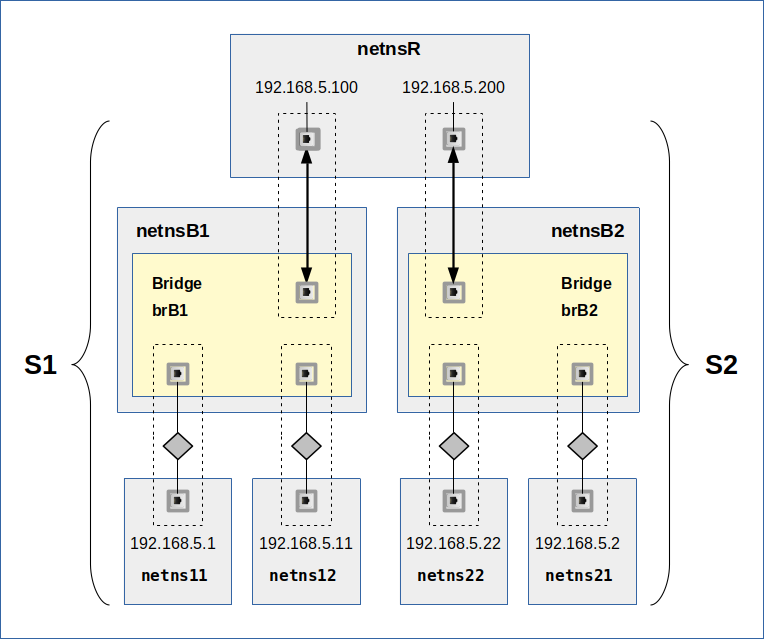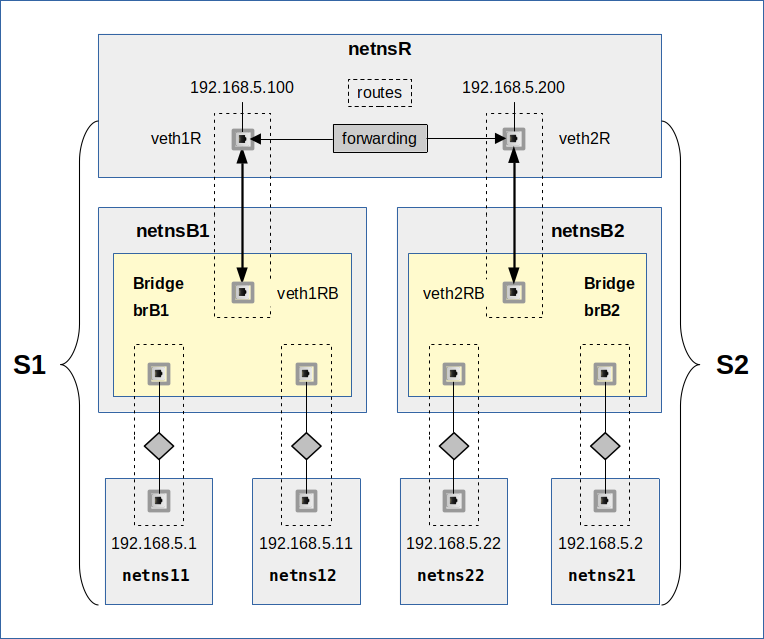In the first post of this series about virtual networking
More fun with veth, network namespaces, VLANs – I – open questions
I have collected some questions which had remained open in an older post series of 2017 about veths, unnamed network namespaces and virtual VLANs. In the course of the present series I will try to answer at least some of these questions.
The topic of the present and the next two post will be a special network namespace which we create with an artificial ambiguity regarding the path that ICMP and even ARP packets could take. We will study a scenario with the following basic properties:
We set up two L2-segments, each based on a Linux bridge to which we attach two separate network namespaces by veth devices. These L2-segments will be connected (by further veths) to yet another common, but not forwarding network namespace “netnsR”. The IPs of all veth end-points will be members of one and the same IP-subnet (a class C net).
No VLANs or firewalls will be set up. So, this is a very plain and seemingly simple scenario: Two otherwise separate L2-segments terminate with border NICs in a common network namespace.
Note, however, that our scenario is different from the typical situation of a router or routing namespace: One reason is that our L2-segments and their respective NICs do not belong to different logical IP networks with different IP-broadcast regions. We have just one common C-class IP-subnet and not two different ones. The other other reason is that we will not enable “forwarding” in the coupling namespace “netnsR”.
In this post we will first try to find out by theoretical reasoning what pitfalls may await us and what may be required to enable a symmetric communication between the common namespace netnsR and each of the L2-segments. We will try to identify critical issues which we have to check out in detail by experiments.
One interesting aspect is that the setup basically is totally symmetric. But therefore it is also somewhat ambiguous regarding the possible position of IPs in one of the networks. Naively set routes in netnsR may break or reflect this symmetry on the IP layer. But we shall also consider ARP requests and replies on the Link layer under the conditions of our scenario.
In the next forthcoming post we will verify our ideas and clarify open points by concrete experiments. As long as forwarding is disabled in the coupling namespace netnsR we do not expect any cross-segment transfer of packets. In yet another post we will use our gathered results to establish a symmetric cross-segment communication and study how we must set up routes to achieve this. All these experiments will prepare us for a later investigation of virtual VLANs.
I will use the abbreviation “netns” for network namespaces throughout this post.
Scenario SC-1: Two L2-segments coupled by a common and routing namespace
Let us first look at a graphical drawing showing our scenario:

A simple way to build such a virtual L2-segment is the following:
We set up a Linux bridge (e.g. brB1) in a dedicated network namespace (e.g. netnsB1). Via veth devices we attach two further network namespaces (netns11 and netns12) to the bridge. You may associate the latter namespace with virtual hosts reduced to elementary networking abilities. As I have shown in my previous post series of the year 2017 we can enter such a network namespace and execute shell commands there; see here. The veth endpoints in netns11 and netns12 get IP addresses.
We build two of such segments, S1 and S2, with each of the respective bridges located in its own namespace (netnsB1 and netnsB2). Then we use further veth devices to connect the two bridges (= segments) to a common namespace (netnsR). Despite setting default routes we do not enable forwarding in netnsR.
The graphics shows that we all in all have 7 network namespaces:
- netns11, netns12, netns21, netns22 represent hosts with NICs and IPs that want to communicate with other hosts.
- netnsB1 and netnsB2 host the Linux bridges.
- netnsR is a non-forwarding namespace where both segments, S1 and S2, terminate – each via a border NIC (veth-endpoint).
netnsR is the namespace which is most interesting in our scenario: Without special measures packets from netns11 will not reach netns21 or netns22. So, we have indeed realized two separated L2-segments S1 and S2 attached to a common network namespace.
The sketch makes it clear that communication within each of the segments is possible: netns11 will certainly be able to communicate with netns12. The same holds for netns21 and netns22.
But we cannot be so sure what will happen with e.g. ARP and ICMP request and/or answering packets send from netnsR to one of the four namespaces netns11, netns12, netns21, netns22. You may guess that this might depend on route definitions. I come back to this point in a minute.
Regarding IP addresses: Outside the bridges we must assign IP addresses to the respective veth endpoints. As said: During the setup of the devices I use IP-addresses of one and the same class C network: 192.168.5.0/24. The bridges themselves do not need assigned IPs. In our scenario the bridges could at least in principle have been replaced by a Hub or even by an Ethernet bus cable with outtakes.
Side remark: Do not forget that a Linux bridge can in principle get an IP address itself and work as a special NIC connected to the bridge ports. We do, however, not need or use this capability in our scenario.
Regarding routes: Of course we need to define routes in all of the namespaces. Otherwise the NICs with IPs would not become operative. In a first naive approach we will just rely on the routes which are automatically generated when we create the NICs. We will see that this leads to a somewhat artificial situation in netnsR. Both routes will point to the same IP-subnet 192.168.5.0/24 – but via different NICs.
Theoretical analysis of the situation of and within netnsR
Both L2-segments terminate in netnsR. The role of netnsR basically is very similar to that of a router, but with more ambiguity and uncertainty because both border NICs belong to the same IP-subnet.
Continue reading →



